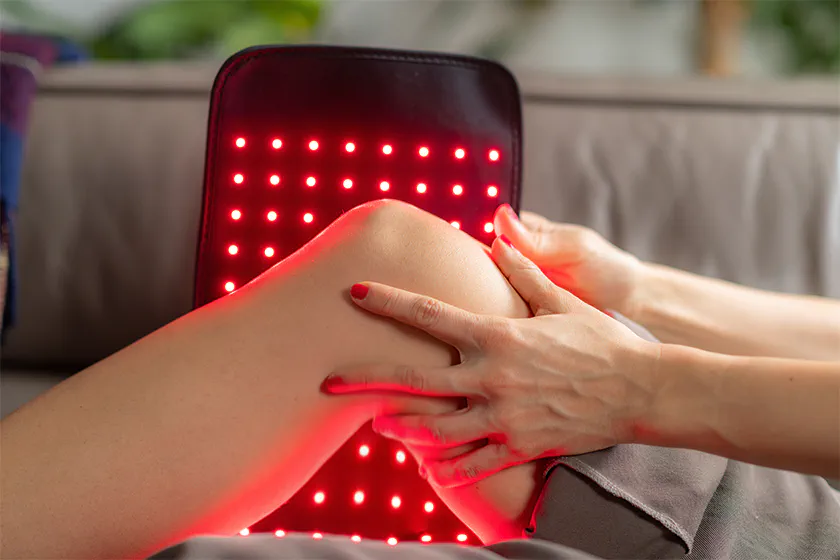Red Light Therapy: What It Is and How It Supports Your Health

Doesn’t it seem like the buzz around red light therapy (RLT) is everywhere these days? RLT has emerged as a popular, non-invasive treatment to promote full-body healing and healthy-looking skin.
You may have noticed that RLT face masks and beds have become commonplace in medspas, tanning salons, gyms, and even medical offices.
So, what exactly is red light therapy, and is it worth all this hype? We are going to break down everything you need to know!
What is Red Light Therapy and How Does it Work?
Red light therapy is a non-invasive treatment that uses specific low-level wavelengths of red light to activate natural healing processes within the body. These light waves penetrate the skin and reach deep into the cells, where they enhance the production of adenosine triphosphate (ATP). This is beneficial because ATP is an energy source that powers cellular repair and tissue regeneration.
One of the standout benefits of RLT is that it can stimulate collagen production. Collagen is the protein responsible for skin elasticity and firmness, and as we age, our natural production declines. So, increased collagen means fewer fine lines and wrinkles. This is one of the reasons why this treatment is finding its way into more dermatology clinics. It’s becoming a game changer when it comes to natural and non-invasive anti-aging treatments.
Health Benefits of Red Light Therapy
Ongoing research continues to highlight the wide-ranging benefits of red light therapy. From muscle recovery to mood enhancement, here are some of the most promising uses:
Eases Pain and Speeds Up Muscle Recovery
Red light therapy has helped many athletes recover from injuries and speed up muscle recovery. RLT does this by increasing blood circulation to affected areas, which reduces inflammation and pain. Studies are continuing to back up these claims, finding that it is a beneficial, non-invasive option for improving muscle function during rehabilitation.
Enhances Skin Appearance and Texture
We’ve already mentioned that red light therapy is beneficial for anti-aging, but its skin health benefits don’t stop there! It also helps address common skin concerns like acne, scarring, and uneven skin tone. The therapy promotes cell turnover and boosts collagen and elastin production, leading to healthier, smoother skin over time. Several clinical trials have demonstrated its safety and effectiveness as a skin rejuvenation method.
Supports Mood and Emotional Well-being
Red light therapy may also benefit those struggling with Seasonal Affective Disorder (SAD) or low energy during winter months. Exposure to red light has been linked to the release of serotonin, the “feel-good” brain chemical that helps regulate mood and sleep. This makes RLT a potential tool for improving mental clarity, mood, and energy levels.
Promotes Wound Healing
Medical professionals are starting to utilize RLT in clinical settings to help speed up wound healing. Its anti-inflammatory effects, combined with its ability to stimulate tissue regeneration, make it useful for healing burns, surgical wounds, cuts, and abrasions.
How to Get Started with Red Light Therapy
RLT is now more accessible than ever, thanks to at-home devices like Joovv, Mito Red, and Omnilux. These tools allow you to enjoy the benefits of red light therapy from the comfort of your home, though they may be less powerful than the professional-grade equipment used in clinics and spas.
For optimal results, most protocols recommend using red light therapy 2-3 times per week for about 10-20 minutes per session. However, it all depends on the device, as some may require longer or more frequent sessions.
Final Thoughts
Red light therapy is a trending wellness treatment with several health benefits for both body and mind. Whether you’re exploring RLT for its anti-aging properties, its recovery support, or simply to feel your best, this low-risk, non-invasive therapy may be a valuable addition to your routine.
As always, it’s a good idea to speak with your healthcare provider before starting a new treatment, especially if you have pre-existing conditions or are taking medications that affect light sensitivity.
Jordana Tobelem, RD, LDN, is a Registered Dietitian passionate about empowering individuals to reach their full potential through nutrition education. Drawing on her clinical dietetics background, she offers consulting services to a variety of healthcare brands and organizations. Jordana stays up to date with the latest nutrition research to develop impactful content for her clients. She holds dual academic degrees in Business and Dietetics.



